Excerpts from Jim Conrad's
Naturalist Newsletter
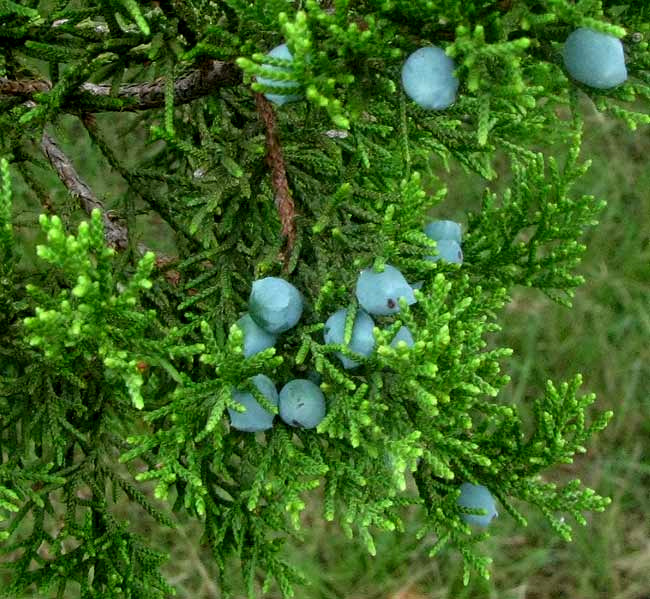
from the the September 2, 2012 Issued from the valley of the Dry Frio River in northern Uvalde County, southwestern Texas, on the southern border of the Edwards Plateau; elevation ~1750m (~5750 ft); N29.62°, W99.86°; USA
ASHE JUNIPERS & THEIR CONTROVERSY
Before I arrived in Uvalde County I knew that Ashe Junipers, JUNIPERUS ASHEI, would be common here, for I'd studied closely the big, detailed "Vegetation/ Cover Types of Texas" map in the University of Texas's wonderful Perry-Castañeda Library Map Collection, [no longer... ] free for everyone to see.
That map clearly shows that here in northern Uvalde County (the second rectangular county west of San Antonio) there are two main vegetation types. The blue one marked 26a is "Live Oak - Ashe Juniper Parks" while the green one marked as 27 is "Live Oak - Ashe Juniper Woods." The difference between the two zones is that trees in the "parks" are wider spaced than in the "woods." Live Oaks and Ashe Junipers, then, are the dominant natural trees here. Ashe Junipers are endemic to Texas, northern Mexico, and spottily here and there in extreme southern Missouri, Arkansas and Oklahoma. They are a unique and little known species, except in our area, where they are abundant.
Ashe Junipers form a pretty, parklike setting right behind the cabin I'm staying in. Below you can see how they produce several trunks with branches bearing dark green clumps of scalelike foliage, like the East's Redcedars and the North's Common Junipers (both members of the genus Juniperus):
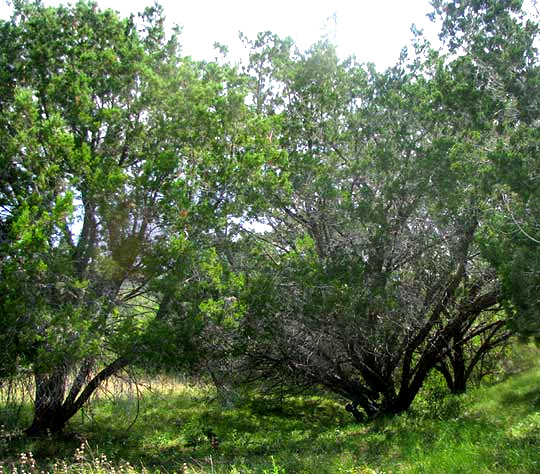
The trunks are particularly "shaggy," as shown below:
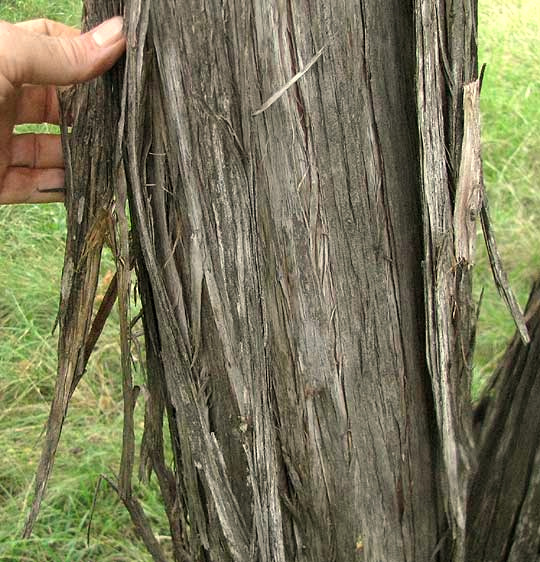
A close-up of leaves and pale blue seed cones is shown at the top of this page.
The cones' paleness is caused by a silvery "bloom." A thumb can rub off the bloom very easily. Technically such a bloom, which also covers certain plums and other fruits, is referred to as glaucescence. This cone glaucescence helps distinguish Ashe Junipers from certain other juniper species farther north at higher elevations. A close-up showing cones with some of their bloom rubbed off is shown below:
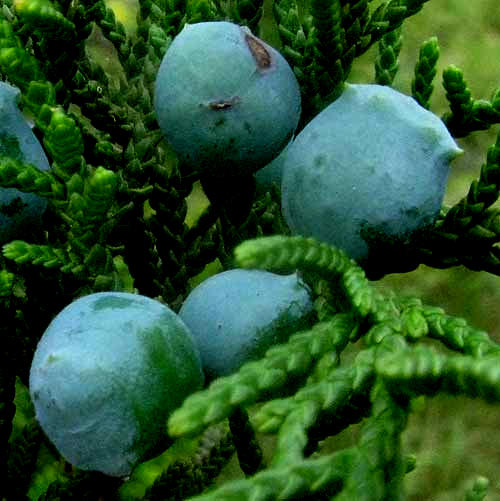
A close-up showing scale-like leaves, each one with a noticeable bump at its base, is shown below:
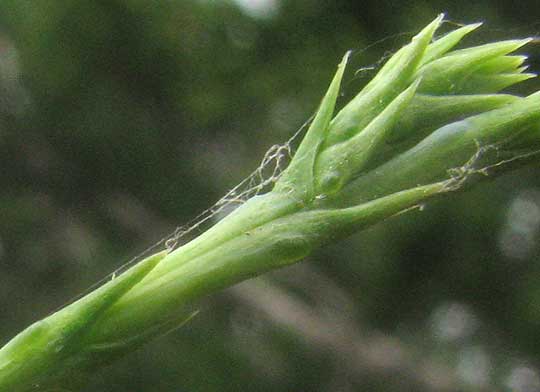
I'm focusing on details here because in this area a certain controversy rages with regard to the Ashe Juniper and I can imagine individuals invested in one side or the other claiming that I must be talking about some other species. Anyone who sees our pictures and knows what an Ashe Juniper looks like will understand that here we're dealing with Ashe Junipers.
In front of the house where I live the landowner on one side of the hill has removed all Ashe Junipers, as you can see below:
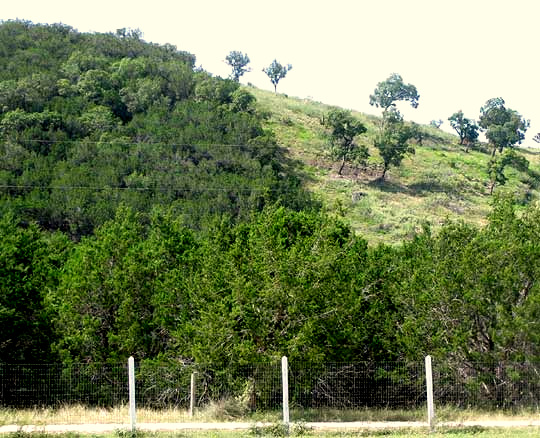
In fact, most of the landowners in this community are "eradicating" the Ashe Junipers on their land. Even people not in favor of the idea are paying hundreds and even thousands of dollars to get rid of their Ashe Junipers because they want to be "good neighbors," and the community consensus is that the Ashe Junipers have to go.
from the December 23, 2012 Issued from the valley of the Dry Frio River in northern Uvalde County, southwestern Texas, on the southern border of the Edwards Plateau; elevation ~1750m (~5750 ft); N29.62°, W99.86°; USA
ASHE JUNIPER'S CLOUDS OF POLLEN
My shoulder brushed an Ashe Juniper's branch and a big puff of powdery stuff clouded from the tree. I stepped back, got the camera ready, shook a branch, and got the picture shown below:
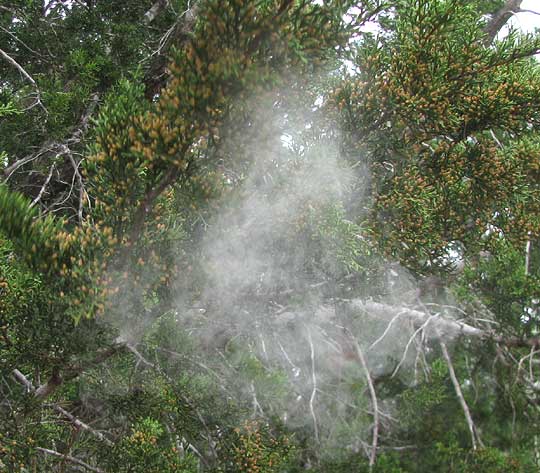
I'd been expecting this because for the last few weeks abundant, pale, 1/8th-inch high (3mm) male cones have been appearing at the tips of the junipers' branchlets, as shown below:
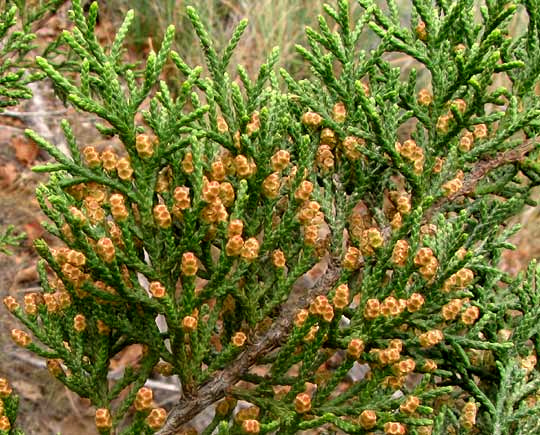
A close-up of some pollen-producing male cones is below:
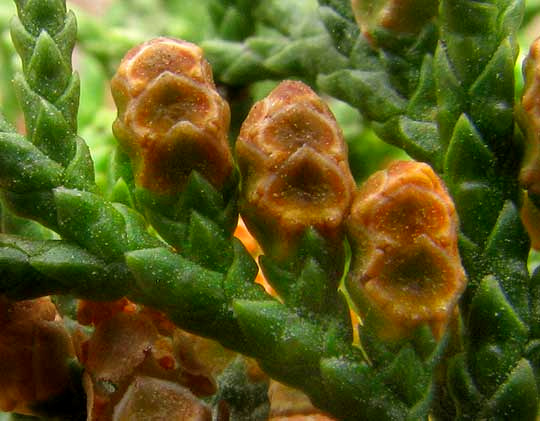
Each brown, triangular scale on the male cones is a sporophyll subtending two pollen sacs. A sporophyll is a modified leaf bearing sporangia or, in this case, pollen sacs. I nipped off the top of a male cone so you can see the spherical, yellow pollen sacs as seen beneath the dissecting scope below:
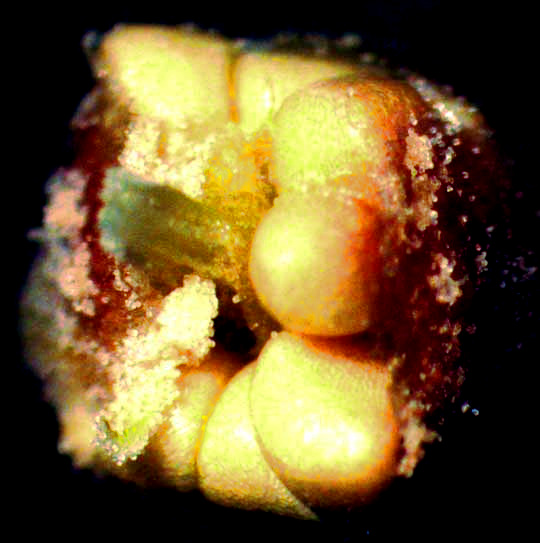
In that picture pollen grains from a ruptured sac coat the sporophyll scales.
If Ashe Juniper male cones are producing prodigious quantities of pollen these days there must be receptive female cones in the vicinity. In contrast to the very conspicuous male cones, you have to look a bit before you find the females nestled down among the junipers' scaly leaves. You can see one below:
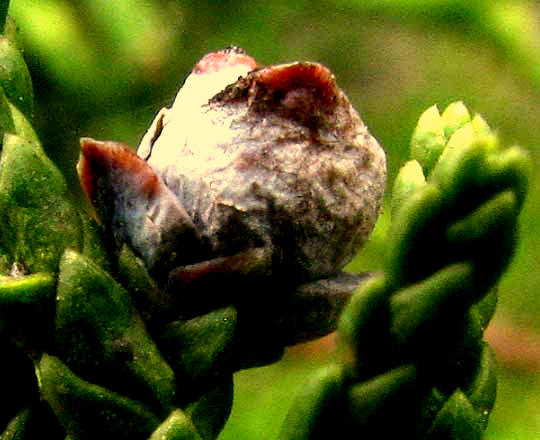
Female cones also consist of pairs or whorls of sporophyll scales, except that in their case the scales subtend ovules. It's interesting that at this early stage of development already the future fruit is whitish with the frosty covering referred to as glaucescence. Toward the top of this page we show very glaucous immature fruits as they appeared in September. Below you can see that on the mature fruits in December the glaucescence persists:
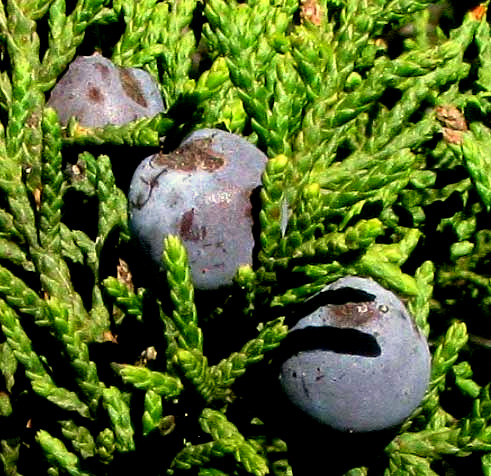
Nowadays on sunny, windy days the air is full of juniper pollen and some people tell me that for them it's a time for sneezing and having watery eyes.
from the October 13, 2013 Newsletter issued from the Frio Canyon Nature Education Center in the valley of the Dry Frio River in northern Uvalde County, southwestern Texas, on the southern border of the Edwards Plateau; elevation ~1750m (~5750 ft); N29.62°, W99.86°; USA
JUNIPER PARADOX
Many landowners in this area feel that if they allow Ashe Junipers to grow on their property they are being bad neighbors. That's because, they tell you, the junipers -- called "cedars" here -- "suck up" vast amounts of water, and are an invasive species that came into the area maybe 40 years ago. Many landowners spend a lot of money to have their junipers cut, heaped into piles, and burnt. I've had no luck convincing anyone that, in fact, Ashe Junipers are a native, co-dominant species in our natural Liveoak-Juniper forests, and that they don't use more water than other species.
This week a friend brought to my attention a 2010 paper by B.P. Wilcox and Y Huang entitled "Woody plant encroachment paradox: Rivers rebound as degraded grasslands convert to woodlands," appearing in Geophysical Research Letters 37. The "degraded grasslands" in the title are mainly ranchland overgrazed by cattle and/or goats, and the "woody plant encroachment" is mainly encroachment by Ashe Junipers.
Having analyzed stream-flow trends of four major rivers over a period of 85 years here in the Edwards Plateau, this was their conclusion:
"... contrary to common and widespread perceptions, streamflows have not been declining. In fact, the contribution of baseflow (supplied by springs and groundwater) has doubled —- even though woody plant cover has expanded and rainfall amounts have remained relatively constant."
You can read the paper's abstract for free, or buy the paper in PDF format, at http://onlinelibrary.wiley.com/doi/10.1029/2009GL041929/abstract.
from the January 19, 2014 Newsletter issued from the Frio Canyon Nature Education Center in the valley of the Dry Frio River in northern Uvalde County, southwestern Texas, on the southern border of the Edwards Plateau; elevation ~1750m (~5750 ft); N29.62°, W99.86°; USA
FIRE-ALARM POLLEN
One chilly, early morning this week I was exploring along the Dry Frio when I looked up and saw smoke rising from the woods, shown below:
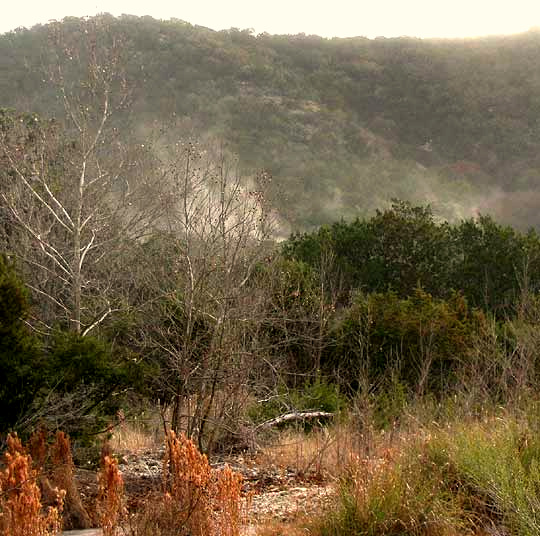
My heart skipped a beat because with our drought and the very dry state of things, a fire can spread fast and be dangerous.
But, I wasn't smelling smoke, and it didn't seem right that smoke should suddenly rise all along a whole slope without my having noticed a smaller fire earlier. And then it dawned on me: It wasn't smoke, but rather pollen. After a cold night the sun was just breaking over the hills, things were drying out fast as the temperature rose, and the day's first wind was gushing up the canyon. With binoculars I could better see what was going on, as shown below with a view through a sycamore tree heavy with fruit-balls:
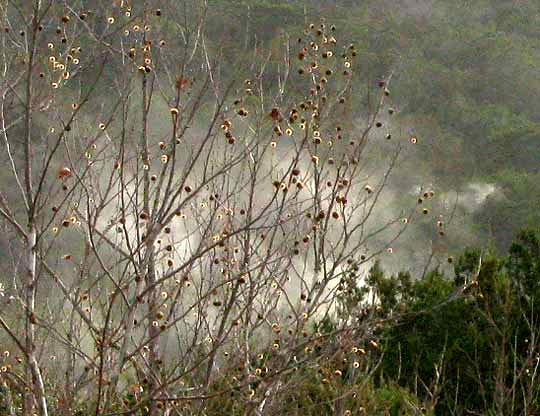
At the far right in that picture you can see pollen exploding from the top of an Ash Juniper. As the wind rose, the whole valley whitened exactly as if filled with smoke. Later I heard that a bit south someone had alerted the community fire department to a fire in the scrub and the fire truck had gone out, only to find a valley filled with pollen from male Ashe Junipers. It was an amazing thing to see. Several people in the community are practically incapacitated with their pollen allergies. I'm lucky to get by with one sneezing fit each morning and then it's over for me.
from the February 16, 2014 Newsletter issued from the Frio Canyon Nature Education Center in the valley of the Dry Frio River in northern Uvalde County, southwestern Texas, on the southern border of the Edwards Plateau; elevation ~1750m (~5750 ft); N29.62°, W99.86°; USA
BARK BEETLES
Our forests here on the southern slope of the Edwards Plateau are dominated by two main native trees, the Texas Live Oak and the Ashe Juniper. In an earlier Newsletter we saw that our liveoaks are suffering from "Oak Decline," at the root of which is the severe stress brought on by our multi-year drought. The stress makes trees vulnerable to a wide range of disease organisms that in normal times wouldn't amount to much. Nowadays bark beetle holes are showing up in our second dominant tree species, the Ashe Juniper, two resin-oozing holes of which are shown below:
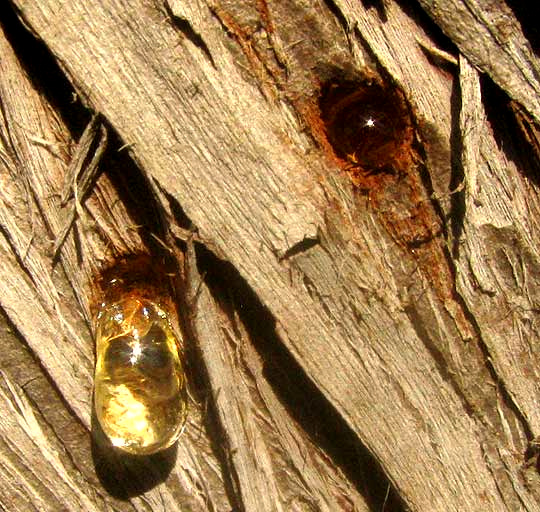
Normally a few bark beetles won't imperil a tree, but when trees are weakened by long-term droughts and other stresses, the beetles can attack en masse, ultimately killing the tree.
from the May 25, 2014 Newsletter issued from the Frio Canyon Nature Education Center in the valley of the Dry Frio River in northern Uvalde County, southwestern Texas, on the southern border of the Edwards Plateau; elevation ~1750m (~5750 ft); N29.62°, W99.86°; USA
JUNIPERS RETURNING TO A CLEARED FIELD
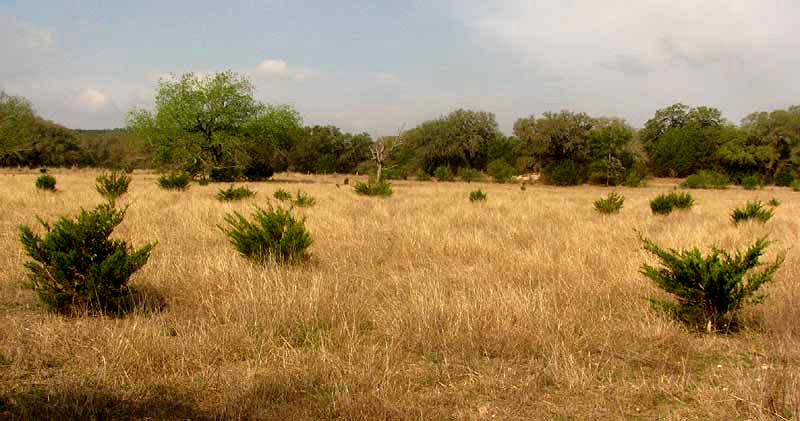
Above you can see a field in the Dry Frio Valley where the two most striking features are that Ashe Junipers are making a gradual come-back after being cleared from the field a few years ago; and the field itself is parched and crisp with dryness, indicating just how severe our drought is. This time last year the field was green, and I'm told that at this time in years before that it was not only green but also resplendent with untold numbers of flowering wildflowers.
Ashe Junipers don't sprout from their bases when their tops are removed, so these young trees "parachuted" into their locations as seeds in bird droppings.
I'm delighted with the Ashe Juniper's ability to rebound despite the constant struggle of many landowners to exterminate it. Viewing the picture, it's easy to believe that in a few years, if left alone, this field will be a juniper forest. The Ashe Juniper controversy, the false notions behind people's efforts to exterminate them, and documentation relating to it all is available in earlier essays presented above
One reason people give for killing them is that they don't want junipers to take over everyplace. It's true that in certain locations junipers can create almost pure stands, but from the sky you can see the real situation, as shown below in a Google Earth photo:
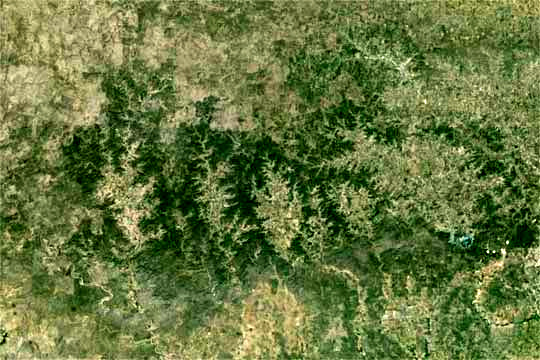
In that picture of the southern edge of the Edwards Plateau, the dark areas are wooded slopes dominated by Ashe Junipers. The much more abundant pale zones are pastures, fields, agricultural land or scrubland, either on gently rolling land atop the plateau at the top of the picture (north), or level land of the lower Coastal Plain at the bottom of the picture, or deforested river valleys cutting across the center of the picture. The pale dendritic patterns within the dark band of junipers across the image's center are deforested valley floors draining onto the Coastal Plain to the south. Our Dry Frio River Valley is one of the smaller valleys, wedged between the much larger Nueces and Frio River Valleys, appearing on the image as the two largest dendritic patterns on the image's left side. The point is that on a regional basis forested land is relatively restricted.
As we've documented in this Newsletter, our Ashe Juniper-dominated hills harbor a remarkable assemblage of narrowly endemic species exquisitely adapted to just our area, and to just our precise conditions. When I see a field being invaded by Ashe Junipers where earlier all junipers had been cut, piled into heaps and burned, I am deeply gratified.